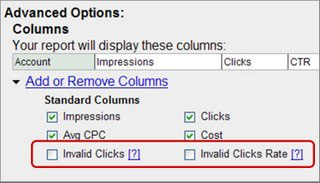Click fraud: Google 'estimating invalid clicks', transparency or PR?

The click fraud battle involves engineering, accounting, and public relations.
In “Google to offer advertisers click fraud stats,” CNET reports:
Responding to concerns about click fraud in the online-ad industry, Google will be revealing to advertisers the number of invalid clicks on their ads.
Shuman Ghosemajumder, business product manager for trust and safety at Google is quoted:
Our goal is to provide that transparency so advertisers who previously may have been unnerved or concerned about these wildly exaggerated figures will be able to see now what Google is doing to protect them.
The Google AdWords blog heralds “a new AdWords feature enabling advertisers to have a much more detailed picture of invalid click activity in their account.”
More details, however, may not represent all the details. As reported by CNET:
Google has had to limit the data it provides to prevent fraudsters from reverse engineering its systems and methods of operation, according to Ghosemajumder.
The graphic below shows the addition of two “invalid clicks” options in the Google AdWords reporting tool.

Google is integrating such “invalid clicks” “reporting” to support its position that “Google’s efforts against click fraud are in fact reasonable.” (see “Court expert on CPC model: 'inherently vulnerable to click fraud')
In the click fraud battle, however, “reasonable” does not appear to be sufficient to fully protect advertisers.
In “Click fraud: are advertisers sufficiently protected?” I cite Dr. Alexander Tuzhilin, NYU Professor of Information Systems, from his 47-page court-requested analysis of the mechanisms underlying search engine PPC-CPC ad models prepared as part of the ongoing Lane’s Gifts v. Google click fraud case.
The Pay Per Click (PPC) — Cost Per Click (CPC) search advertising model is “inherently vulnerable to click fraud,” according to Tuzhilin:
the measures…are only statistical measures providing some evidence that Google’s filters work reasonably well. This does not mean, however, that any particular advertiser cannot be hurt badly by fraudulent attacks, given the evidence that Google filters ‘work.’ Since Google has a very large number of advertisers, one particular bad incident will be lost in the overall statistics. Good performance measures indicative that filters work well only mean that there will be ‘relatively few’ such bad cases.
Danny Sullivan, Search Engine Watch, underscores the need for advertisers to continue to be “prudent”:
I suspect anyone seeing high levels of invalid clicks being caught might also want to take a harder look at what they are actually getting billed for beyond this, since the high rate might suggest they are in a click-fraud prone industry and perhaps stuff is still slipping past the Google filters. Of course, a low rate might warrant a further look since perhaps Google's not catching stuff it should.
Confused? Here's the overriding advice. Everyone should be auditing their click logs, watching for odd things, just as you would your credit card statement. Google and Yahoo both have long had systems in place to automatically catch fraud. The Google move significantly helps advertisers understand that this protection is already in place. But it doesn't relieve the advertiser of being prudent and doing their own review, as well.